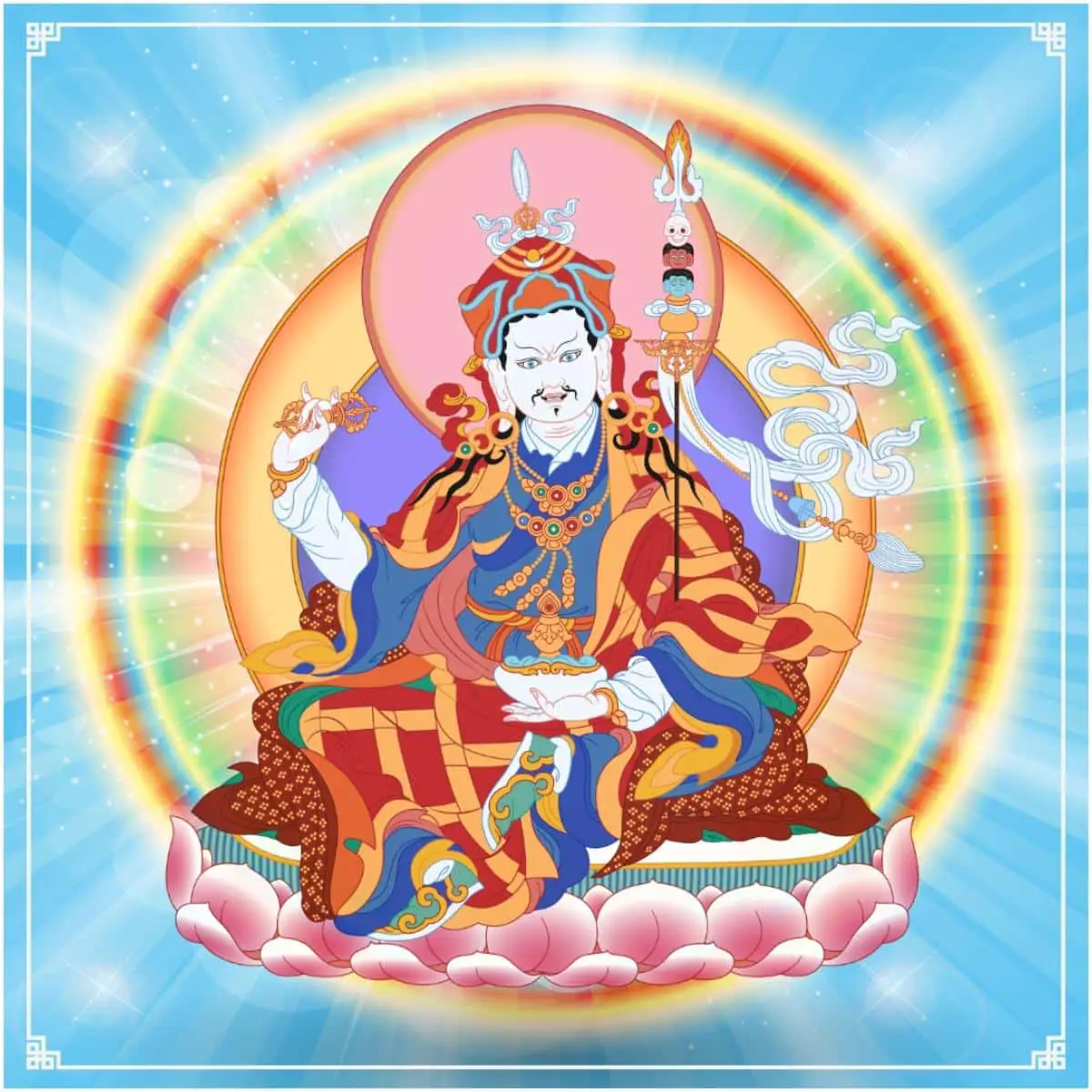Buddhist prayer – Seven Line Prayer lyrics:
Hung orgyen yul gyi nubjang tsam,
Pema gesar dongpo la,
Yatsen chok gi ngödrub nye,
Pema jungne shye su drak,
Khor du khandro mangpo kor,
Khye kyi jesu dak drub kyi,
Jingyi lab chir shek su sol,
Guru pema siddhi hung.
Translation:
Huṃ! In the northwest of the land of Oḍḍiyaṇa,
In the heart of a lotus flower,
Endowed with a marvelous attainments,
You are renowned as the Lotus Born,
Surrounded by many hosts of ḍakinis,
Following in your footsteps,
I pray to you: Come, inspire me with your blessing!
The Seven Line Prayer (Guru Rinpoche Buddhist prayer) is also known as The Seven Verses of the Vajra or the King of Prayers.
This powerful chant is the most sacred and important Tibetan prayer in the Dzogchen and Nyingma traditions and is extremely popular throughout Tibet, Bhutan, and the Himalayas. At first glance, this Buddhist prayer is a straightforward supplication.
Under closer inspection, however, the prayer unfolds a few different levels of symbolism and meaning, ultimately and miraculously revealing itself to be a condensed treasury of Dharma (spiritual teachings) instruction and blessing.
“This is the most majestic of all prayers to Guru Padmasambhava – the Buddha (Shakyamuni) for our time. It has been cherished over the centuries as the most powerful way to invoke his blessings.” – Sogyal Rinpoche’s quote, author of The Tibetan Book of Living and Dying.
READ MORE: Chenrezig Mantra (Avalokiteshvara Mantra) – Lyrics
Buddhist Prayer – The Seven Line Prayer meaning:
This ancient Buddhist prayer has three levels of meaning – Outer, Inner, and Secret. Outer meaning is simple as it is, this is a prayer to Guru Rinpoche Padmasambhava.
The practitioner will find the Inner meaning when his mind mixes with the Guru Padmasambhava’s mind, and they become inseparable. The secret meaning of the prayer is not learned by the practitioner until he has accumulated 300,000 repetitions of The Seven Line Prayer.
“The Vajra Seven-Line Prayer enshrines the most sacred supplication to Guru Padmasambhava. White Lotus elucidates its five layers of meaning as revealed by the eminent scholar Mipham the Great.
This is a prayer to and meditation on Guru Padmasambhava, the self-present primordial wisdom of the mind, the changeless great bliss of the vajra-body, the innate radiance of wisdom light – Buddhahood.” – Tulku Thondup Rinpoche’s quote, author of Peaceful Death, Joyful Rebirth and The Healing Power of Mind.

mr_owlman/Shutterstock
The Seven Line Prayer explanation, according to Chökyi Drakpa (only the last line):
- HUNG is an expression of magnetism, and a skillful represents to invoke the wisdom minds of the jnanasattvas.
- GURU represents the spiritual master (teacher).
- PADMA represents that he is an emanation of Buddha Amitabha since Buddha Amitabha belongs to the Buddha family of lotus speech.
- SIDDHI represents spiritual accomplishments.
- HUNG for gathering. So altogether it represents, ”Gather the accomplishments of the Lotus Master!”
Chanting benefits, explained by His Holiness Sera Yangtrul Rinpoche:
“When oneself or others feel any discomfort in the body, or if the environment is unclean, or when meeting with any obstacle or negative provocation, just reciting this prayer of seven vajra verses with a completely sincere mind, all the Buddhas, Bodhisattvas, Gurus, Triple Gems, virtuous protecting Dharmapalas would be sure to arrive and render help or give blessings.”
“The overall significance of the Seven-Line Prayer is perhaps best appreciated in relation to a practice called guru-yoga, or “union with the nature of the guru.”
The purpose of guru-yoga is to purify and deepen the student’s relationship with his or her teacher. It is introduced as one of the preliminary practices, and it remains crucial – in fact, its importance increases – as one progresses through the higher advanced levels of the tantric path.
The cultivation of devotion to the guru and the blending of one’s mind with his or her enlightened mind is, in the words of Dilgo Khyentse Rinpoche, ‘the most vital and necessary of all practices and is in itself the surest and fastest way to reach the goal of enlightenment.’” – Jamgon Mipham’s quote.
Read on insightstate more healing mantras, like: Vajrasattva Mantra or Reverse Negative to Positive Mantra.
